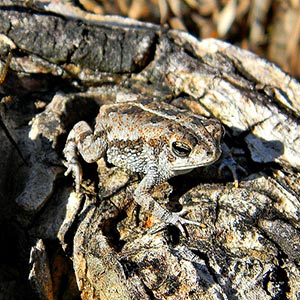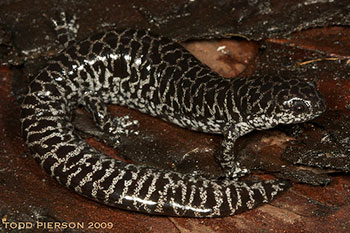
Amphibians are a part of many people’s childhood memories: Finding tadpoles, or “pollywogs,” in puddles; checking under logs for creepy, crawly newts; catching toads; or imitating the call of bullfrogs. Because amphibians are found in all kinds of environments, most of us can find some wherever we live.
Growing up in Vermont, I was especially partial to the red eft, as the bright-orange, juvenile stage of the eastern newt is sometimes known. In this stage, they are land-dwelling before they head back to the water for adulthood. I used to like to count them when I went on walks with my mom and the dog.
If you’ve been counting your own local amphibians in recent years, you may have noticed a decline. Or maybe you’ve noticed a drop in the nighttime calls of your neighborhood’s frogs. Though it’s been recognized that amphibian numbers have been declining for years, a recent U.S. Geological Survey study published in the journal PLOS One is the first to analyze the rate of this decline. And what it found was not optimistic. The researchers discovered an overall decline in amphibian numbers of 3.7 percent each year since 2002. What’s more, that number jumps to 11.6 percent when looking at amphibian species that are listed as endangered by the International Union for Conservation of Nature (IUCN). The exact reasons for the alarming decline are unknown, but likely include a combination of factors such as invasive species, climate change and pollutants.

Amphibian decline is bad news for ecosystems, as they play an important role in the food web as both prey for larger animals and predator for smaller ones. In fact, in many areas of drastic amphibian decline, there has been an increase in pests that damage crops. Beyond that, amphibians are important indicators of environmental health. Their thin skin helps them breath and drink, but makes them some of the first to succumb to environmental changes, meaning that when they start suffering, other animals and humans could be next.
This by itself is enough to make amphibian populations important, but besides that, amphibians are just too cool! Did you know that:
- Young Surinam toads emerge from their mother’s back.
- The spring peeper survives through winter with 65 percent of its body water as ice.
- The slimy salamander produces a sticky substance that glues shut the mouth of predators that dare to mess with it.
- The oak toad is the smallest toad in North America.
- The flatwoods salamander spends most of its life underground, earning it and others in the same family the nickname “mole salamanders.” This federally endangered species is endemic to the lower Gulf and Atlantic coastal plains where its longleaf pine habitat — much of it shared with the oak toad — has been reduced to 20 percent of its historical range. For years, American Forests has been working to restore the longleaf pine for the oak toad, the flatwood salamander and a host of other endangered species that rely on it.

And the red eft? They are luckily counted among the species of least concern according to the IUCN, but that doesn’t put them in the clear. The U.S. Geological Survey researchers observed declines in every data set they studied, including species of least concern.
Many amphibians rely on forests as their habitat and their declining numbers indicate that these forests are in trouble. Help us protect and restore the forests that these amazing creatures call home.